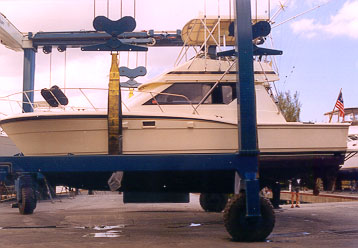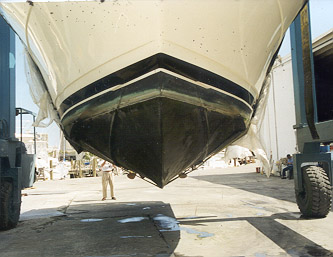Hatteras 38 Convertible
Updated Review
by David Pascoe

| LOA | 37'10" | Engines | DD 6-71TI |
| Beam | 13'10" | Fuel | 475 gals |
| Draft | 4'4" | Speed | 25 kn |
| Weight | 32,500 | Year | 1988 |
| Production run: 1988 - 1993 | |||
The more recent sibling to the 36 and 37 Convertibles, it's very much the same boat but with the furniture arranged differently and a tad larger. It's 1'10" longer than the 37 and weighs about 3,000 pounds more, but you'll still find it with those great 6-71 Detroit Diesels that will push it along at respectable speeds. All three of these boats are a great choice in this category, with the major difference being age.
The 36 is the older of the three, yet for several years both the 36 and 37 were offered side by side (possibly an inventory problem here). The 37 is actually only 6" longer than the 36. The 38 makes its first appearance in 1988, the 36 in 1983. Appearance-wise, the major difference is the aft raking house windows, no front windshields, and a redesigned bridge layout. The cockpit could be a tad larger, though I didn't measure it and could be wrong about that, but it's definitely bigger than the 36.
The 38 now has balsa cored hull sides, whereas the other two don't. Other than that, all three appear to have the same basic hull shape, except that the 38 has a moderately deep keel and 4'4" draft, whereas the 37 has no keel and a 3'3" advertised draft. The deck is glassed to the hull and the rub rails seems to be considerably beefed up over earlier models where stress cracking was a common occurrence on the toe rails. Zero stress cracks on this one. Or maybe the owner just knew how to drive it. I'd opt for the former.
The 38 sports a single 475 gallon fiberglass fuel tank, more than a third larger than the 330 gallons of the earlier models. This is much larger than you'll find in most similar boats. Needless to say, with full fuel and water, it slows down a bit more.
As mentioned in my other reviews, one thing I really like about this boat is that it is about as low maintenance as you can get. There is really very little to keep up with on the exterior - no wood, no cheap plastic or aluminum junk (other than the window frames) to run the maintenance bills up. Our survey model was 12 years old, spent its life in south Florida, and had the original paint that still looked very good. Only the decks non-skid had been repainted along with the aluminum window frames.

This view should leave you with little doubt about how well this hull will perform in rough water. Compare this with the hull shape shown below. The trade-off is performance over interior space.
When it comes to convertible sedans of this size, there are two ways to go. You can have a good sea performer, or you can have a beautiful, spacious interior. You can't have both. Hatteras opted, as they always have, for performance, and that's what this boat is all about. Shown right is a photo of the bow entry of this boat compared to that of your typical "family cruiser." If you know your way around boats, these photos tell the whole story. The forefoot is VERY deep and slices through waves very nicely, thank you. Combined with its heavy weight (Travelift scale read 32, 500 lbs with 3/4 fuel), it is a first rate rough water performer. End of story.
Yet even with JT 6-71TIBs souped up to 456 hp, it's not a speed demon. Twenty five knots tops with a 21-22 knot cruise upwind with a half tower. And the lifespan is in the dumps at that power rating. 410 hp is the limit for good longevity with this engine. That's an historical fact, so forget about what anyone else may say. Cat 3208's at 375 hp are the other engine option, so figure 18-21 knots with these engines. But because of her deep hull and weight, this boat does not perform well at 18 knots. She really needs to be kicked up to 20 before she rides at optimal trim and efficiency. I wouldn't want this boat with anything but the 6-71's.
In terms of overall quality for a production boat, they don't get any better than this unless you want to move up to a late model at double the price. The interior is your basic Hatteras Afromosia dark paneling in the salon, with light vinyls forward to lighten things up a bit. Whereas the you'll find the 36 & 37's with dark wood forward.
(Note: Many people mistake this wood for teak. Actually, it's a very hard, very durable veneered plywood called Afromosia, which I conclude is the most durable wood paneling material available. While many people want light colored woods such as white oak or ash, those woods are highly susceptible to staining and are a poor choice as far as durability is concerned.)
With two staterooms forward, the areas are a bit cramped, though bigger than the comparable Bertram models, but not claustrophobically so. At least there are no colliding doors. As typical in this size boat, the master cabin (this doesn't really qualify as a STATE room) double berth takes up most of the floor space. But hey, there's a foot space down each side so that you at least don't have to crawl in bed head first, on hands and knees. Oh, how I detest beds like that -- especially when you're trying to bring food and drink with you, as I usually do. Yeah, I know, Moma said you're not supposed to eat in bed, but somehow that never quite sunk in.......
The galley is best described as unremarkable. The usual L-shape with all the usual stuff in the usual places. The storage space in the immediate galley area is less than adequate, and you may have to use other cabinets within the salon to store galley stuff.
The door is in the center with an L-shaped sofa aft and to starboard, again, the same old layout because there's not much else you can do with these smaller boats. No room to get fancy. The space really comes from its nearly 14 foot beam, so while small, it's not cramped and you're not likely to trip over the coffee table because there's room to walk by it. The catwalks are wide, so there's good storage space up underneath. The salon may tend to look smaller because the area up under where the windshield used to be is filled with cabinets, but the deck space remains the same. On the one side is where the microwave goes, the other the TV and other such goodies get built in.
Head size is adequate with fiberglass stall shower and Vacuflush system. This system has finally been perfected, and works well. You could put your pants on in there without a serious struggle. You can sit on the head to tie your shoe laces. As for two in the shower, well, it could be done without much bruising.
One really nice feature are the optional, built in tackle centers that are all 'glass, hold up well, and are nicely designed for a variety of uses other than just fishing junk and stinky bait. The in-deck fish box is huge, and though it takes two people to lift it out, it's very light and comes out easily. Not like wresting with an alligator, as most are. Below, everything is immediately reachable for servicing.
The bridge sacrifices some practicality for style and space with the swept-back forward coaming. It's definitely smaller than the earlier 37' models. There's room for two pedastal chairs, though the driver has to move out of the way to let someone sitting in the passenger seat pass by. Otherwise, the ergonomics are pretty good. The ladder up to the bridge has winged handrailings, making for an easier climb, though the ladder is smack in front of the bait freezer and gets in the way a bit. The objective here is obviously to allow adequate room for a fighting chair.
The generator is at aft engine room and is a bit tough to reach due to two salon deck supports that get in your way. This engine room layout could have been done better. For example, there is an open bilge sump pit full of oily water that one nearly has to step in to get forward and outboard of the engines. Were it not for this, servicing stuff at this end wouldn't be much of a problem, and I would certainly make some adjustments here so as to avoid this unpleasantness if you're a do-it-yourselfer.
There are no air conditioners under the beds. The compressors are in the engine room where they belong.
All hardware is stainless steel and is solidly bolted. No loose, leaking stanchion bases. No plastic hardware crumbing in the noonday sun.
No stress cracks in superstructure or decks. No leaky windows or hatches. No crushed or stress crack rub rails.
After 12 years with good maintenance in the tropics, this does not look like an old boat. No one would be embarrassed with this one. It's a fine example of good engineering in a boat that's built to last.
Price at this point in time: around $200K, more for later models.
Posted March 10, 2000
 Visit davidpascoe.com for his power boat books
Visit davidpascoe.com for his power boat books 














David Pascoe is a second generation marine surveyor in his family who began his surveying career at age 16 as an apprentice in 1965 as the era of wooden boats was drawing to a close.
Certified by the National Association of Marine Surveyors in 1972, he has conducted over 5,000 pre purchase surveys in addition to having conducted hundreds of boating accident investigations, including fires, sinkings, hull failures and machinery failure analysis.
Over forty years of knowledge and experience are brought to bear in following books. David Pascoe is the author of:
In addition to readers in the United States, boaters and boat industry professionals worldwide from nearly 80 countries have purchased David Pascoe's books, since introduction of his first book in 2001.
In 2012, David Pascoe has retired from marine surveying business at age 65.
On November 23rd, 2018, David Pascoe has passed away at age 71.
Biography - Long version